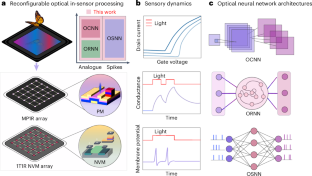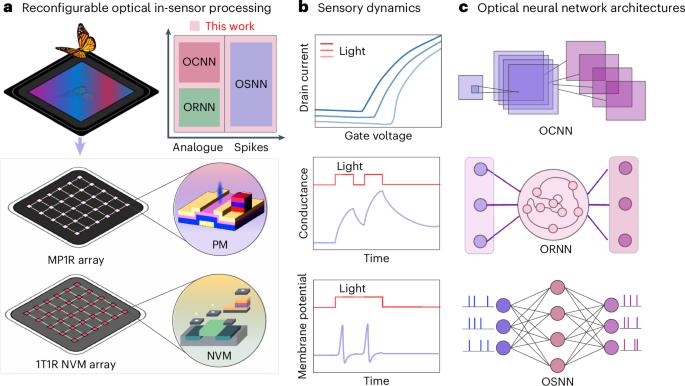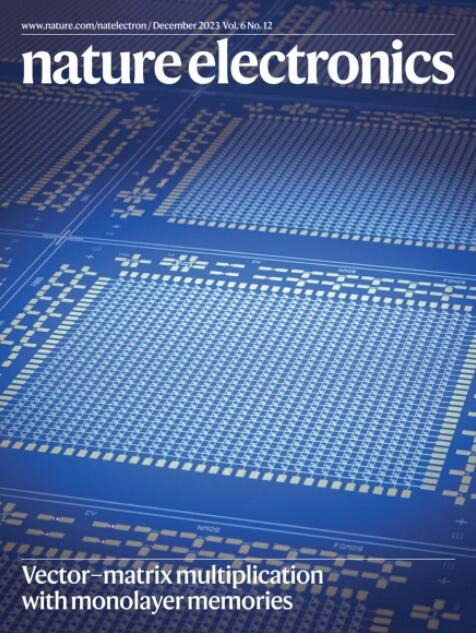Reconfigurable in-sensor processing based on a multi-phototransistor–one-memristor array
IF 33.7
1区 工程技术
Q1 ENGINEERING, ELECTRICAL & ELECTRONIC
引用次数: 0
Abstract
Memristors with photonic sensory capabilities can be used as elements in machine vision systems but face challenges in terms of encoding and processing optical data. This has led to different neural network architectures being developed for specific vision tasks, which limits progress towards more versatile in-sensor vision computing platforms. Here we describe a multi-phototransistor and one-memristor array that is based on niobium oxide memristors. It has reconfigurable dynamics and is compatible with both machine learning (analogue) and bioinspired (spiking) neural network architectures. The array can sense and process optical images and synchronize spatio-temporal data across different encoding formats. When the array is coupled with a classifier network using a one-transistor and one-memristor non-volatile memory array, it supports a variety of optical neural networks (including optical convolutional neural networks, recurrent neural networks and spiking neural networks). The resulting system can perform various computing vision tasks, such as recognizing static, motion and colour images. Niobium oxide memristors with reconfigurable dynamics can be used to make an array integrated with phototransistors that can encode image information in analogue or spiking form and can support different neural network architectures for image processing tasks.


基于多光电晶体管一晶闸管阵列的可重构传感器内处理技术
具有光子传感功能的晶体管可用作机器视觉系统的元件,但在编码和处理光学数据方面面临挑战。这导致针对特定视觉任务开发了不同的神经网络架构,从而限制了向更多功能传感器内视觉计算平台迈进的步伐。在此,我们介绍一种基于氧化铌忆阻器的多光电晶体管和单忆阻器阵列。它具有可重新配置的动态特性,并与机器学习(模拟)和生物启发(尖峰)神经网络架构兼容。该阵列可以感测和处理光学图像,并同步不同编码格式的时空数据。当该阵列与使用一个晶体管和一个晶闸管非易失性存储器阵列的分类器网络耦合时,它可支持各种光学神经网络(包括光学卷积神经网络、递归神经网络和尖峰神经网络)。由此产生的系统可以执行各种计算视觉任务,如识别静态、动态和彩色图像。
本文章由计算机程序翻译,如有差异,请以英文原文为准。
求助全文
约1分钟内获得全文
求助全文
来源期刊

Nature Electronics
Engineering-Electrical and Electronic Engineering
CiteScore
47.50
自引率
2.30%
发文量
159
期刊介绍:
Nature Electronics is a comprehensive journal that publishes both fundamental and applied research in the field of electronics. It encompasses a wide range of topics, including the study of new phenomena and devices, the design and construction of electronic circuits, and the practical applications of electronics. In addition, the journal explores the commercial and industrial aspects of electronics research.
The primary focus of Nature Electronics is on the development of technology and its potential impact on society. The journal incorporates the contributions of scientists, engineers, and industry professionals, offering a platform for their research findings. Moreover, Nature Electronics provides insightful commentary, thorough reviews, and analysis of the key issues that shape the field, as well as the technologies that are reshaping society.
Like all journals within the prestigious Nature brand, Nature Electronics upholds the highest standards of quality. It maintains a dedicated team of professional editors and follows a fair and rigorous peer-review process. The journal also ensures impeccable copy-editing and production, enabling swift publication. Additionally, Nature Electronics prides itself on its editorial independence, ensuring unbiased and impartial reporting.
In summary, Nature Electronics is a leading journal that publishes cutting-edge research in electronics. With its multidisciplinary approach and commitment to excellence, the journal serves as a valuable resource for scientists, engineers, and industry professionals seeking to stay at the forefront of advancements in the field.
 求助内容:
求助内容: 应助结果提醒方式:
应助结果提醒方式:


